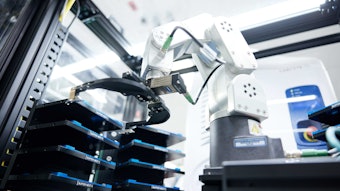As part of P&F magazine's continuing series of F&F expert insights, Rich Boden, senior research fellow at IFF, addresses aroma chemical chemistry and research. Send us your own thoughts and feedback here.
The creation of new and unique aroma chemicals has always represented a pursuit of effectiveness and cost-efficiency, but with today’s heightening ecological sensitivities, there is the additional concern that aroma chemicals and their processes be sustainable as well. To serve all these ends at once, increasing global competition demands that fragrance developers incorporate innovative and sophisticated chemical processes and technologies discovered by researchers in areas outside the fragrance industry.
In the context of aroma chemistry, sustainability connotes discovery and production processes that are environmentally benign. To be sustainable, a chemical and its production process should eliminate or reduce ingredients such as solvents and hazardous reagents, as well as waste (including water), energy and any other product or process that might negatively impact the environment.
Today, aroma chemical research is reaping the benefits of new knowledge bases created by pharmaceutical and petroleum chemical research. The incorporation of the knowledge and skills gleaned from the identification, synthesis, and purification of complex pharmaceutical molecules has added new methodologies and tools to the fragrance ingredient chemist’s palette.
In the quest to convert crude oil into chemically functional raw materials, the petroleum industry has contributed new technologies resulting in reaction-specific, recyclable catalysts that yield small molecule building blocks. Originally designed for the next generation of high performance polymers and specialty functional fluids, these new raw materials are allowing the fragrance chemist to create unusual molecular structures possessing unique organoleptic properties.
Utilizing chlorophyll and enzyme catalysts, plants transform carbon dioxide extracted from the air, water from the soil, and energy from the sun to create complex life-sustaining chemicals, as well as the essential oils and aroma chemicals employed in perfumes for products ranging from home care to fine fragrances.
Microbiologists use bacteria as the “chemical reactor and catalyst” for the enzymatic process known as fermentation. From this “natural” and sustainable chemistry, we derive functional organic chemicals which represent finished products or the raw materials for aroma chemicals. For example, scaleriolide, an intermediate for the synthesis of IFF ingredient Amberiff,a is the result of the fermentation of Scaleriol (IFF, US5,212,078) in the presence of Cryptococus albidus ATCC 20918.
Molecular biologists and enzymologists are now intensively researching ways of using recombinant microorganisms, enzymes or plants as sustainable sources of highly desirable aroma chemicals. Extensive research, especially in the area of pharmaceutical synthesis, is currently underway to identify recombinant processes that can be used in place of hazardous reagents and chemical processes. These designer reagents may be the sustainable key to a wealth of important naturals as well as chiral or optically active fragrance ingredients.
For instance, enzymatic processes produce chiral or optically active ingredients. A chiral ingredient can exhibit different odor profiles and can be best explained as the difference between your right and left hands. Although they appear to be the same, your palms are pointed in opposite directions. Molecules possessing a right or left “handedness” will rotate light to either the right or the left direction. This is exemplified by the odors of d-carvone, a right-handed molecule possessing the odor of caraway seed, and l-carvone, a left-handed molecule which has the odor of spearmint.
In its simplest form, the synthesis of an aroma chemical can result in the formation of an equal number of right- and left-handed molecules (defined as a racemic mixture). Since desired biological activity is usually associated with only one form (right- or left-handed), pharmaceutical research has focused on synthesizing molecules of specific rotation. To this end, a number of catalysts have been created that give primarily one form over the other. Fragrance chemists are utilizing this chemistry to exclusively create the desirable component of a racemic mixture. Since these catalytic methods create the molecule with the desired odor profile, waste and environmental impact are reduced.
Plants have evolved using enzymes as catalysts resulting in the large variety of chemicals found in nature; chemists have learned, with the help of powerful and relatively inexpensive computer technology, to understand the chemical behavior of these special reagents. Through the incorporation of computer modeling programs, computer controlled reactors and instrumentation, the next generation of aroma chemicals will be discovered, safely produced, and brought to market.
It is now commonplace to use computer programs to analyze the prodigious amount of data generated in typical catalyst studies. Reaction variables such as temperature, pressure, reagent flow rates and changes in the physical properties of the reaction mass are, with the aid of computers, correlated in real time along with spectral data obtained within the reaction vessel to provide insight into the reactivity of the catalyst. Computer controlled calorimetry (the measurement of heat generated by a chemical reaction) experiments provide process safety data as well as mechanistic information that allow the chemist to modify reaction conditions to obtain higher yields and to lower costs.
Introduction of the computer controlled microreactor, a workhorse in pharmaceutical research, will be the tool of choice for discovering, developing, and producing tomorrow’s aroma chemicals. Microreactors are reaction vessels that offer finer control of reaction conditions and variables. Unlike conventional reactors, microreactors possess a high surface-to-volume ratio, allowing for better heat dissipation that results in improved temperature control and safer processes. The reaction zone is relatively small and products are removed quickly, resulting in higher yields and greater product purity. Since there is less opportunity to create byproducts by overreaction, there are fewer impurities to contribute off notes to the odor profile. Microreactors are energy efficient tools that maximize chemical production and minimize the formation of waste products; they are potent research and production tools that play an integral role in designing sustainable chemistry.
While the central goals of effectiveness and cost-efficiency have not diminished in importance, the emerging trend of sustainability can be expected to have a growing impact on the discovery and synthesis of new aroma chemicals and processes for the foreseeable future.
aAmberiff is a trademark of IFF
About Rich Boden
Richard Boden is a senior research fellow specializing in innovation at IFF. Upon receiving his PhD in organic chemistry (phase transfer catalysis and the synthesis of narcotic antagonists) from the University of Rochester, New York, he joined IFF R&D in 1978. His expertise is in the areas of organic synthesis and fragrance applications; during a career spanning more than 30 years he has accumulated a portfolio in excess of 200 patents and publications.










